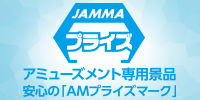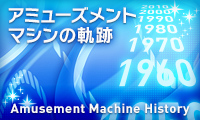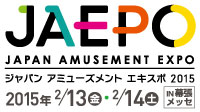English
REFERENCE MATERIALS
Standards for Elimination of Unhealthy Amusement Machinery
Purpose of Amendment
Since its establishment, the Japan Amusement Machinery Manufacturers Association (JAMMA) has continuously pursued the development of a healthy amusement industry. In order to achieve this aim, JAMMA has established ethical standards concerning the functioning and construction of machinery, and adopted measures prohibiting its members from manufacturing and selling unhealthy machinery. At the same time, it has sought to raise public awareness of the development of healthy amusement machinery by, for example, distributing posters and fliers. Steps such as these taken by the industry have been focused on promoting the healthy development of the amusement industry as a whole.
The initial definition of unhealthy machinery can be found in the Standards for Elimination of Gambling Machinery formulated in May 1982 soon after the foundation of JAMMA. The standards were subsequently amended and renamed the Standards for Elimination of Unhealthy Amusement Machinery in September 1991, when a framework for screening visual representations was incorporated.
The amendment of the Standards for Elimination of Unhealthy Amusement Machinery was made to meet the needs of the times and better achieve JAMMA's desired objectives by responding to the recent technological advances in amusement machinery and relaxing regulation of those aspects of amusement machines and the amusement machinery industry that have developed in a healthy manner.
Standards for Elimination of Unhealthy Amusement Machinery
- 1.Purpose
- The purpose of the Standards for Elimination of Unhealthy Machinery (hereinafter called "the Machinery Standards") is to contribute to the development of the amusement machinery industry through their use by the Japan Amusement Machinery Manufacturers Association (hereinafter called "JAMMA") in the promotion and administration of various measures intended to eliminate machines that are contrary to public order and morals in order to establish a healthy and orderly amusement machinery industry.
- 2.Scope of application
-
The Standards shall apply to the following types of amusement machines used for commercial purposes. JAMMA members shall not manufacture, sell or operate unhealthy amusement machinery in or for use in Japan.
- 2.1
-
TV game machines
TV game machines Machines with video screens operated for commercial purposes by use of prepaid (including postpaid) cards and/or coins.
- 2.2
-
Token-operated game machines
Token-in/token-out machines operated for commercial purposes.
- 3.Definitions
-
The principal definitions used in the Machinery Standards are as follows:
- 3.1
-
Commercial amusement machines
Mainly amusement facilities used for business purposes as defined under Article 2.1.8 of the Law Regulating Adult Entertainment Businesses, etc.
- 3.2
-
Unhealthy machinery
Machines with any one or more of the features of types of machines stipulated in Article 4 and machines deemed by JAMMA to be contrary to public order and morals.
- 4.Features of types of machines
-
- 4.1
-
TV game machines
- (1)
- Content: Machines depicting content contrary to public order and/or content that is obscene, extremely violent or extremely cruel. (Whether or not machines depict content contrary to public order or obscene, extremely violent or extremely cruel content shall be determined by JAMMA in accordance with the Ethical Screening Criteria.)
- (2)
- Other features: Machines that may easily be modified in a manner contrary to public order and morals.
- 4.2
-
Token-operated game machines
- (1)
-
Functional and structural features
- [1] Game machines for adults
-
- i
- Machines that cannot be operated using tokens.
- ii
- Machines with no device for paying out tokens.
- iii
- Machines in which tokens won are not paid out but are credited. However, machines equipped with payout switches (push buttons) enabling players to obtain tokens they have won whenever they wish are excluded.
- iv
- Machines structured so that tokens can be credited by operating switches or other devices and the number of credited tokens recorded by a meter.
- v
- Machines that can be operated using bank notes. However, token dispensers located between machines functioning as separate token dispensers and incapable of communication with game machines themselves are excluded.
- vi
- Machines that can be operated by inserting coins that are credited immediately.
- [2] Game machines for children
-
- i
- Machines that cannot be operated using tokens.
- ii
- Machines with no device to pay out tokens.
- iii
- Machines in which tokens won are not paid out but are credited. However, machines equipped with payout switches (push buttons) enabling players to obtain tokens they have won whenever they wish are excluded.
- iv
- Machines structured so that tokens can be credited by operating switches or other devices and the number of credited tokens is recorded by a meter.
- v
- Machines structured so that the maximum number of prize tokens paid out in one play exceeds 99 pieces (i.e. a payout in excess of 99 tokens for a single play not a payout in excess of 99 times the credited amount even when multiple tokens are credited in a single play).
- vi
- Machines with a three-way structure that immediately credit coins in excess of \100 in value.
- vii
- Machines that can be operated using bank notes and/or \ 500 coins, etc.
- (2)
-
Other features
Machines with any of the features specified in Article 4.2(1) and machines that may be easily modified by such methods as swapping ROM or altering dip switches in a manner that is contrary to public order and morals.
- Supplementary provisions
-
- 1.
- Rules on Application of the Standards for Elimination of Unhealthy Amusement Machinery are provided separately to enable the aims of the Machinery Standards to be achieved.
- 2.
- The Machinery Standards are effective from October 1, 1999.














